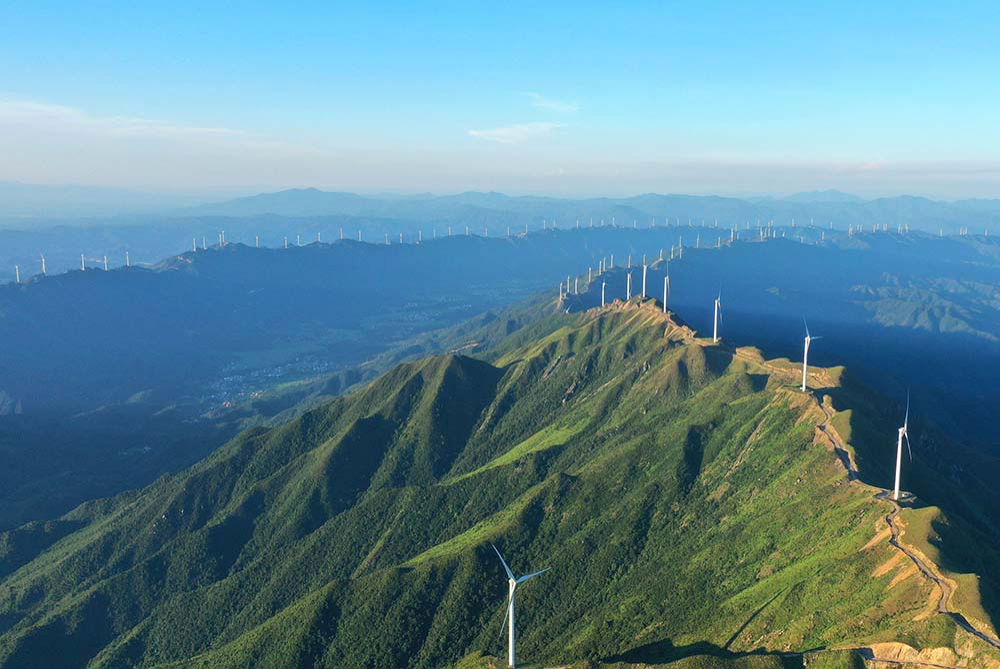CHINA is making remarkable progress towards achieving its carbon emission peaking and neutrality goals by 2030 and 2060 respectively in line with the guiding policy introduced to ensure the achievements of these milestones.
The guiding document unveiled in October 2021envisions that by 2030, China’s carbon dioxide emissions will peak, stabilize and then decline and that by 2026, the country will be carbon neutral, fully accomplishing its vision for an ecological civilization.
China’s remarkable progress towards achieving its carbon emission and neutrality targets was highlighted by Professor Hazhen Gong of the Renmin University of China on Tuesday 3 June in Beijing when lecturing international journalists attending a media exchange program in China hosted by the Chinese International Press Communication Center (CIPCC).
Prof Going lectured on the subject of “Toward Carbon Neutrality: Sciences, Economics and Strategies”, focussing on the case of China.
China is the leading carbon dioxide emitter in the world, but has invested massively into efforts to accomplish its carbon emission peaking and neutrality goals on schedule.
China’s bid to achieve its 2030 carbon peaking goal has resulted in the reduction of CO2 emissions by more than 65 per cent from the 2005 level, and the 2060 carbon neutrality goal by increasing its energy supply from non-fossil fuels by more than 80 per cent.
Prof Gong said China has achieved almost all of its decarbonization targets, and experts are optimistic that China’s emissions peak nears accomplishment and have largely attributed this progress to the introduction of electric vehicles and renewable energy usage.
She highlighted various general policies and policy instruments that have been put in place for the achievement of these two targets and they include 1+ Policy Framework, apart from China’s Nationally Determined Contributions (NDC) as per the United Nations Framework Convention on Climate Change.
Elaborating on the 1+N Policy, Prof Gong said the framework was designed to pursue the following objectives:
- Optimise the carbon trading market to include more sectors;
- Introduce supporting policies, and legal framework such the Climate Law;
- Develop green finance to expand financial support and investment;
- Promote green and low-carbon technological innovation;
- Develop a circular economy;
- Build a green and low-carbon transportation system;
- Promote energy-saving, low carbon buildings and infrastructure;
- Promote industrial transition;
- Optimise the energy structure; and
- Implement nature-based solution.
She highlighted that the introduction of this mechanism and related policies saw China’s renewable energy boom, with wind and solar growth continuing to break records in 2024.
Prof Gong said in 2020, China set a goal to install at least 1200 gigawatts (GW) of solar and wind power by 2030, and by the end of 2024, it already surpassed this target, reaching the target six years ahead of schedule.
“This was achieved through aggressive investments, government policies, and a surge in solar and wind installations,” she emphasized.

Prof Gong said recently, Ruoqiang PV (Photovoltaic) Project, the largest single installed PV solar power plant in China, was connected to the national grid and put into operation in the desert of Xinjiang region.
“Located in the southeastern Taklamakan Desert, this particular colossal PV project with an installed capacity of 4GW has been developed and operated by China Green Electricity Investment since August 2023, with a total investment of 15.588 billion Yuan.
“This is the first phase of a series of large-scale clean energy projects in Xinjiang and is part of China’s broader agenda to reduce carbon emissions and increase the share of renewable energy in its energy mix.”
Prof Gong also highlighted China’s massive investment into nuclear power, with 29 reactors totalling 33 GW capacity under construction.
She said this makes up nearly half of all nuclear projects worldwide, adding that by 2030, China will surpass the United States as the largest nuclear power producer, with a projected capacity reaching up to 320 GW by 2050.
Prof Gong also highlighted that China is the world’s largest market for low carbon-energy investment, adding that in 2024, the country attracted $818 billion in clean energy investments more than the combined total of the United States, European Union and the United Kingdom. This figure accounted for two-thirds of the global increase in clean energy investments that year.
Carbon Market is a trading system where carbon credits are bought and sold. By assigning property rights to carbon emissions, it establishes a market-based framework where emission allowances become tradeable assets. This system incentivizes the reduction of greenhouse gas emissions. Carbon markets are typically classified based on whether emission reductions are mandatory or voluntary. Compliance carbon market is regulated by law and entities must meet specific emission reduction targets, while the voluntary carbon market participation is optional, and is often driven by corporate sustainability goals or social responsibility.
Prof Gong said China launched its national carbon emissions trading scheme (ETS), which is expected to be the world’s largest carbon market, to curb climate change effects and to achieve the country’s goals of reaching peak emissions by 2030 and zero emissions by 2060.
She said the ETS caps emissions of carbon intensive industries and also emissions of provinces/cities by providing dynamic incentives for low/zero/negative emissions technology innovations and investments, changes in production patters and changes in living styles.
Prof Gong said the implementation of the ETS started with the electricity sector, and saw the regulation of more than 4 billion tons, or 40 per cent of China’s CO2 emissions and 12 per cent of global CO2 emissions. These emission reductions involved more than 2100 enterprises.
She said the compliance rate was 99.5 per cent in in the first compliance cycle, with more than 50 per cent of the regulated enterprises participating in allowance trading operations.
The current carbon price is about USD8-10 per ton with steadily increasing trend, Prof Gong said.
Prof Gong said the sectoral coverage is expected to extend to six carbon-intensive industry sectors by 2030, and the stringency of the sectoral benchmarks will be enhanced step-by-step.
She said auction would be introduced for allowance allocation as early as possible and institutional investors would be allowed to enter the carbon market as early as possible.
The program will transit from a rate-based system to a mass-based system, Prof Gong added.
All in all, Prof Gong highlighted that China is making remarkable progress towards achieving its carbon emission peaking and neutrality targets.
By DELI-SHARON OSO
In Beijing, China




